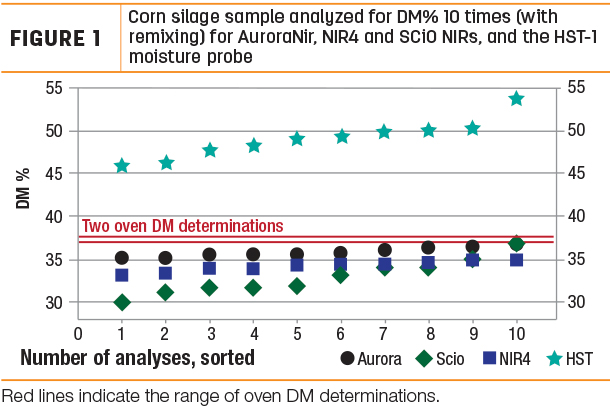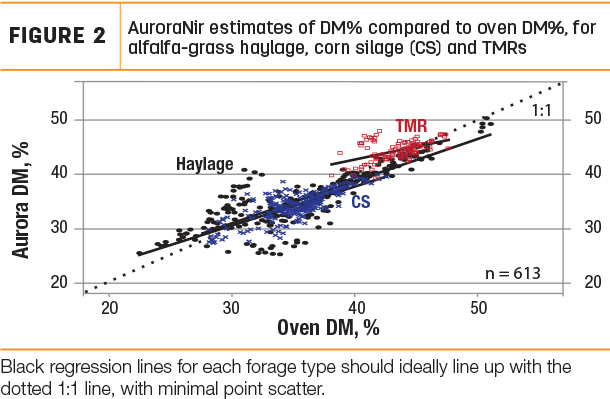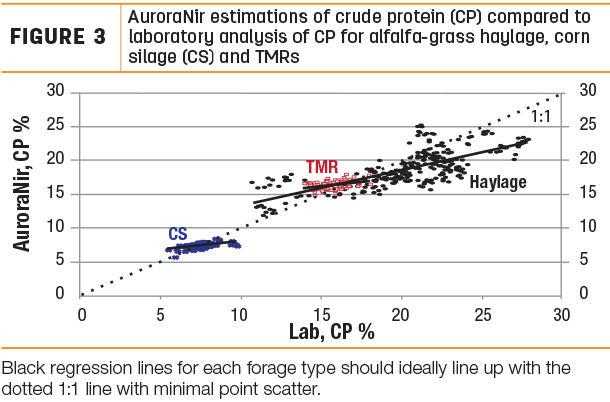Nutrient composition of fed rations differs from formulated rations due to day-to-day variation in dry matter (DM) content and nutrient composition of forages, as well as mixing wagon variation and sorting.
Nutrient composition of fed rations differs from formulated rations due to day-to-day variation in dry matter (DM) content and nutrient composition of forages, as well as mixing wagon variation and sorting. Providing excess feed may mitigate the effects of day-to-day silage variability, but it increases feed costs and is less environmentally acceptable. Many dairy farmers rebalance rations once a week, and a few rebalance rations daily.
Handheld near-infrared reflectance (NIR) instruments are now available for on-farm evaluation of forages. There are a variety of instruments using different technologies with greatly different NIR scanning ranges. However, there is almost no public data or independent evaluation of their relative effectiveness for on-farm forage evaluation. This is the knowledge gap we sought to close.
Day-to-day silage variability
There is variability (error) associated with bunker sampling and analysis we try to minimize with proper sampling techniques and consistent analysis from the same laboratory. There also is real day-to-day variability in bunker DM and in chemical composition. We attempted to quantify how much corn silage, alfalfa silage and total mixed rations (TMRs) varied in DM content and chemical composition during a seven-day period.
We sampled alfalfa grass haylage and corn silage bunkers daily on seven farms in New York over several weeks, as well as some daily TMR sampling. We observed that day-to-day variation in DM percentage over a week was somewhat similar for corn silage and TMRs but was considerably greater for alfalfa grass haylage.
Taking into consideration the variability in sampling and analysis, we concluded that a 7-percentage-unit range in DM over a week was large enough to potentially benefit from daily rebalancing. This 7-percentage- unit threshold was exceeded 14% of weeks for corn silage, 25% of weeks for TMRs and 42% of weeks for haylage. So if DM percentage can be determined accurately on-farm, daily rebalancing should either reduce feed costs due to overfeeding or increase milk production due to underfeeding.
Evaluating NIR calibrations
Initially, we evaluated several NIR handhelds for their ability to analyze dry ground forage samples, comparing them to a laboratory instrument. This was done to provide an assessment of their relative potential for successful operation. Handhelds such as the AuroraNir with a reasonably wide scanning range could be calibrated to evaluate dry, ground forage almost as well as a very expensive lab instrument. Very uniform, finely ground, dry samples, however, are quite different from coarsely chopped, wet silage or TMRs. Next, we evaluated calibrations available for silages on several handheld units.
• Precision. We scanned the same sample 10 times to assess precision, mixing after each scan, for haylage, corn silage and TMRs collected from several farms. Three handheld NIRs were compared to a state-of-the-art electronic impedance moisture probe. An example of results using corn silage is in Figure 1; the distance between the red lines is typical of the relatively small variation in duplicate oven DM determinations.

The AuroraNir and NIR4 were similar in precision, generally with less precision for the SCIO. The HST-1 probe had poor precision. We can work with an instrument that isn’t accurate, but lack of precision means the instrument cannot be fixed with calibration. Depending on how wet the samples are, NIR DM estimates are higher or lower than oven DM.
• Accuracy. We evaluated DM percentage for 613 samples from New York and Wisconsin using the instruments. The SCIO and HST probe did not have a TMR calibration. The most accurate instrument for DM was the AuroraNir (Figure 2), although data analysis indicated the AuroraNir DM calibrations would have limited utility for rebalancing rations.

All three NIR instruments tended to underestimate DM at higher forage DM and overestimate DM at lower forage DM. Some sets of samples were outliers – that is, all the samples from a particular farm were isolated away from the 1-to-1 line and thus poorly predicted. The same sets of samples that were outliers for AuroraNir were also outliers for NIR4. We concluded that calibrations were not robust enough to encompass the range of variability in our sample set. The SCIO accuracy for DM percentage was poor compared to AuroraNir and NIR4, and the HST-1 accuracy was very poor. The AuroraNir was the only instrument with calibrations for typical forage quality parameters. Results for crude protein (CP) are shown in Figure 3.

Crude protein calibrations for haylage, corn silage and TMRs all produced unacceptable results. Once again, samples taken from the same farm, even when they were all collected on different days, were sometimes isolated in groups well separated from the 1-to-1 line. Calibrations for neutral detergent fiber (NDF), acid detergent fiber (ADF) and ash content produced similar unacceptable results.
Summary
The most practical parameter to measure for daily rebalancing of dairy rations is DM, and DM has considerable day-to-day variability for alfalfa grass haylage, with somewhat less variability for corn silage and TMRs in New York. Current calibrations available for three handheld NIRs, however, were not robust enough to provide sufficiently accurate DM percentage to allow for economically beneficial daily rebalancing of dairy rations.
Handheld NIRs with a reasonably wide range of NIR scanning ability can be high-quality, precise scanning instruments. However, they require more robust calibrations for wet, chopped materials to be useful for daily ration rebalancing purposes. Successful calibration will be more challenging for feedstuffs such as corn silage and TMRs, which have a very small range in DM percentage.
More recently available handheld NIR instruments such as those currently marketed by DairyLand Laboratories Inc. in Wisconsin and AgroCares of the Netherlands have a more comprehensive scanning range and may be more effective of DM estimations. An in-depth discussion of our study can be found in the journal Computers & Electronics in Agriculture, 2021.
This study was supported by the New York Farm Viability Institute.











